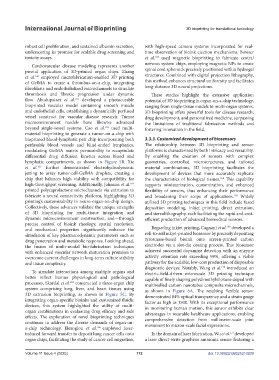Page 120 - v11i4
P. 120
International Journal of Bioprinting 3D bioprinting for translational toxicology
robust cell proliferation, and sustained albumin secretion, with high-speed camera systems incorporated for real-
underscoring its promise for scalable drug screening and time observation of bioink ejection mechanisms. Bowser
toxicity assays. et al. used magnetic bioprinting to fabricate central
167
Cardiovascular disease modeling represents another nervous system chips, employing magnetic NPs to create
pivotal application of 3D-printed organ chips. Zhang spinal cord spheroids precisely positioned within hydrogel
et al. employed microfabrication-enabled 3D printing structures. Combined with digital projection lithography,
160
of GelMA to create a thrombus-on-a-chip, integrating this method enhances structural uniformity and facilitates
fibroblasts and endothelialized microchannels to simulate long-distance 3D neural projections.
thrombosis and fibrotic progression under dynamic These studies highlight the extensive application
flow. Abudupataer et al. developed a photocurable potential of 3D bioprinting in organ-on-a-chip technology,
161
bioprinted vascular model containing smooth muscle ranging from single-tissue models to multi-organ systems.
and endothelial cells, establishing a dynamically perfused 3D bioprinting offers powerful tools for disease research,
vessel construct for vascular disease research. Tumor drug development, and personalized medicine, surpassing
microenvironment models have likewise advanced the limitations of traditional fabrication methods and
beyond single‐vessel systems. Cao et al. used multi- fostering innovation in the field.
162
material bioprinting to generate a tumor-on-a-chip with
bioprinted blood-lymphatic pair chip incorporating both 3.3.3. Customized development of biosensors
perfusable blood vessels and blind-ended lymphatics, The relationship between 3D bioprinting and sensor
modulating GelMA matrix permeability to recapitulate platforms is characterized by both intricacy and versatility.
differential drug diffusion kinetics across blood and By enabling the creation of sensors with complex
lymphatic compartments, as shown in Figure 5B. Xie geometries, controlled microstructures, and tailored
et al. further demonstrated electrohydrodynamic material combinations, 3D bioprinting facilitates the
163
jetting to array tumor-cell-GelMA droplets, creating a development of devices that more accurately replicate
chip that balances high viability with compatibility for the characteristics of biological tissues. This capability
168
high-throughput screening. Additionally, Johnson et al. supports miniaturization, customization, and enhanced
164
printed polycaprolactone microchannels via extrusion to flexibility of sensors, thus enhancing their performance
fabricate a neural connectivity platform, highlighting 3D and broadening their scope of applications. Widely
168
printing’s customizability in neuro-organ-on-chip design. utilized 3D printing techniques in this field include fused
Collectively, these advances validate the unique strengths deposition modeling, inkjet printing, direct extrusion,
of 3D bioprinting for multi-tissue integration and and stereolithography, each facilitating the rapid and cost-
dynamic microenvironment construction, and—through efficient production of advanced biomedical sensors.
precise control of bioink rheology, spatial resolution,
169
and mechanical properties—significantly enhance the Regarding inkjet printing, Cagnani et al. developed a
simulation of key pharmacodynamic parameters such as roll-to-roll inkjet-printed biosensor by precisely depositing
drug penetration and metabolic response. Looking ahead, tyrosinase-based bioink onto screen-printed carbon
the fusion of multi-modal bio-fabrication techniques electrodes via a slot-die coating process. This biosensor
with enhanced vascular network maturation promises to achieved successful dopamine detection with an enzyme
overcome current challenges in long-term culture stability activity retention rate exceeding 98%, offering a viable
and tissue complexity. pathway for the scalable, low-cost production of disposable
170
diagnostic devices. Notably, Wang et al. introduced an
To simulate interactions among multiple organs and electric-field-driven microscale 3D printing technique
better reflect human physiological and pathological capable of finely shaping polydimethylsiloxane doped with
processes, Skardal et al. constructed a three-organ chip multiwalled carbon nanotubes composite microchannels,
165
system comprising lung, liver, and heart tissues using as shown in Figure 6A. The resulting flexible sensor
3D extrusion bioprinting, as shown in Figure 5C. By demonstrated 84% optical transparency and a strain gauge
integrating organ-specific bioinks and customized fluidic factor as high as 1500. With its exceptional performance
devices, this system highlighted the utility of multi- in monitoring human motion, this sensor exhibits clear
organ combinations in evaluating drug efficacy and side advantages in wearable healthcare applications, enabling
effects. The exploration of novel bioprinting techniques comprehensive detection from millimeter-scale joint
continues to address the diverse demands of organ-on- movement to micron-scale facial expressions.
a-chip technology. Elezoglou et al. 166 employed laser-
171
induced forward transfer to deposit lung cancer cells onto In the domain of laser fabrication, Wu et al. developed
organ chips, facilitating the study of cancer cell migration, a laser direct-write graphene ammonia sensor featuring a
Volume 11 Issue 4 (2025) 112 doi: 10.36922/IJB025210209

